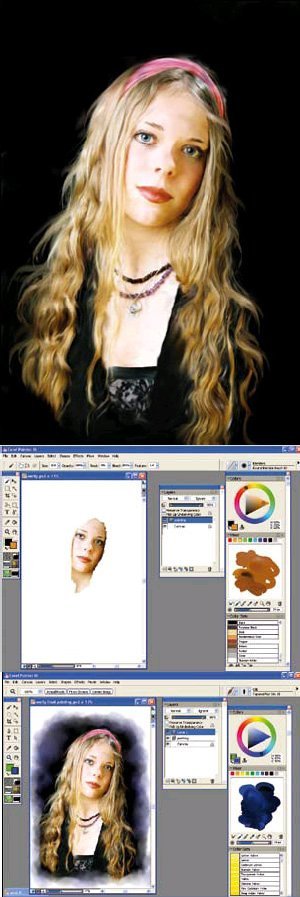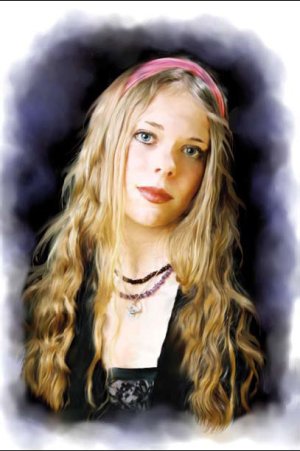articles/Fine-art/artisticendevours-page2
Artistic Endeavors - part 2 of 1 2
Published 01/06/2006

Choosing a Colour
colour can be chosen or created in several ways, such as:
1. Selecting a swatch on the colour palette.
2. Using the eyedropper tool, which samples colour from the image.
3. Using the Mixer palette.
4. Using the Colour Sets palette.
5. Using the Clone Colour setting - this takes colour from a source.
By default the Colour Palette displays the Hue Ring and Saturation Triangle. The apex of the triangle has the highest value white, and the base is your black. Saturation levels go from left to right, the right has the purest colour (note that the triangle is rotated as you change the Hue setting).
Painting the Face
The face is a good place to start painting because it's the most important part of the finished portrait. Start by painting the skin, just like applying make-up, I chose to blend the pixels on the painting layer using Round Blender 30 from the Blenders brush category and worked with a small brush using short circular strokes. For the highlights of the face, add colour with the Digital Airbrush, from the Airbrush category and then blend it using Round Blender 30. Use the same brushes for the rest of the painting (or any other which you may prefer). To check how your work is going, switch the canvas eye off.
Painting the hair
The texture of hair needs a different approach, I applied paint using Tapered Flat Oils from the Oils category, then set to 0% resat,

Clothing
If the material you are to paint is very textured then use chalks and pastels, if the fabric is softer, then use oils and airbrushes.
Softening the Edges
Make a new layer: rename layer 1. Softening the edge of the painting gives a more painterly feel, I used Oil Pastels- Soft Oil Pastel 20, to add colour, then used Detail Blender 5 to blend and soften the edges.
Final colour adjustments and printing (emily final painting) When the painting is finished, bring the file back into Photoshop where a levels adjustment can be carried out again on the painting and layer 1 should you wish to boost the image tone.
Flatten the Image.
Watercolour paintings can be printed onto textured fine art paper, an oil painting will always look better printed onto canvas. Don't forget to sign your work. Jane Conner-ziser has a nice touch here, she uses a gold leaf pen, it certainly adds that extra touch of class.
Please Note:
There is more than one page for this Article.
You are currently on page 2
1st Published 01/06/2006
last update 09/12/2022 14:51:15
More Fine-art Articles
There are 36 days to get ready for The Society of Photographers Convention and Trade Show at The Novotel London West, Hammersmith ...
which starts on Wednesday 14th January 2026





